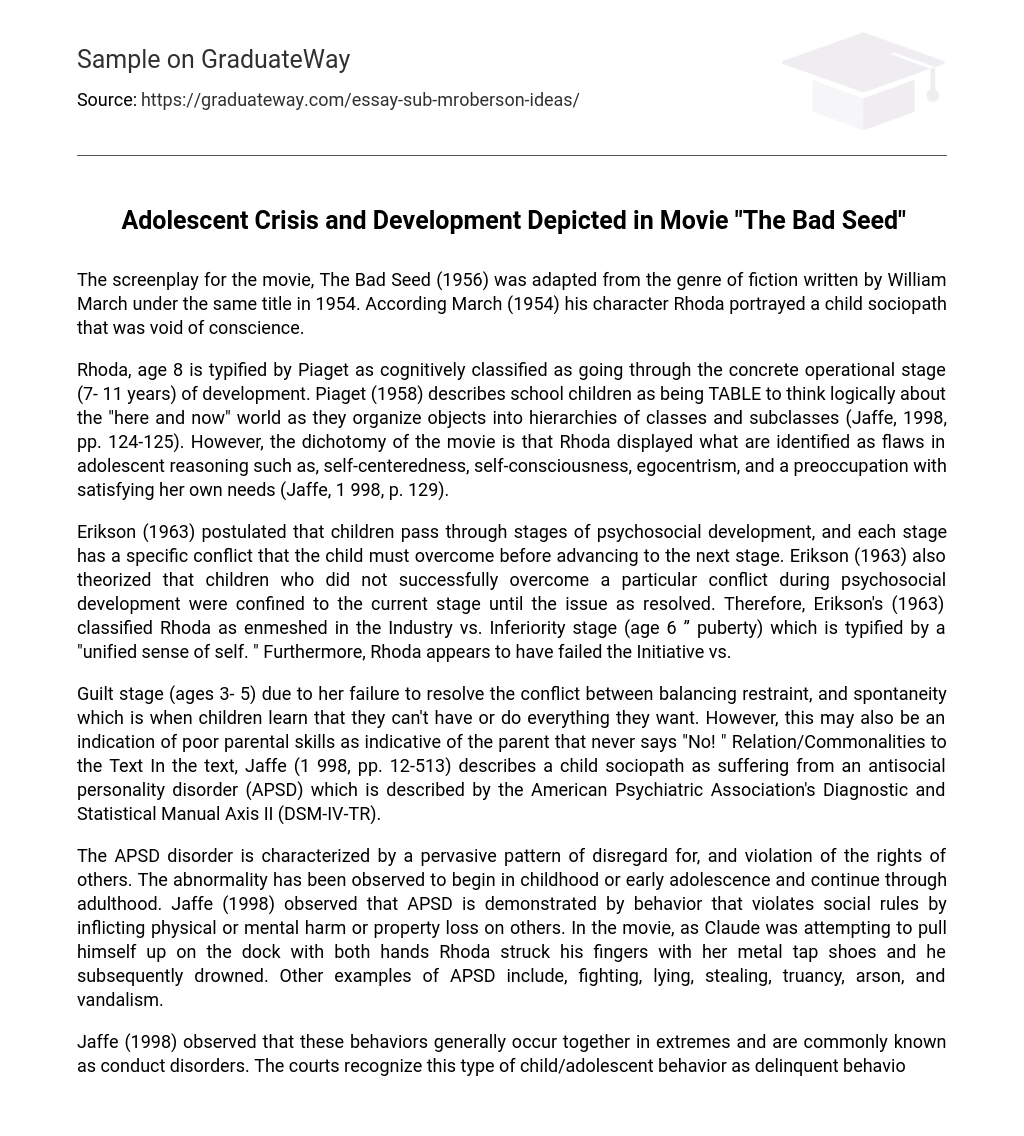The screenplay for the movie, The Bad Seed (1956) was adapted from the genre of fiction written by William March under the same title in 1954. According March (1954) his character Rhoda portrayed a child sociopath that was void of conscience.
Rhoda, age 8 is typified by Piaget as cognitively classified as going through the concrete operational stage (7- 11 years) of development. Piaget (1958) describes school children as being TABLE to think logically about the “here and now” world as they organize objects into hierarchies of classes and subclasses (Jaffe, 1998, pp. 124-125). However, the dichotomy of the movie is that Rhoda displayed what are identified as flaws in adolescent reasoning such as, self-centeredness, self-consciousness, egocentrism, and a preoccupation with satisfying her own needs (Jaffe, 1 998, p. 129).
Erikson (1963) postulated that children pass through stages of psychosocial development, and each stage has a specific conflict that the child must overcome before advancing to the next stage. Erikson (1963) also theorized that children who did not successfully overcome a particular conflict during psychosocial development were confined to the current stage until the issue as resolved. Therefore, Erikson’s (1963) classified Rhoda as enmeshed in the Industry vs. Inferiority stage (age 6 ” puberty) which is typified by a “unified sense of self. ” Furthermore, Rhoda appears to have failed the Initiative vs.
Guilt stage (ages 3- 5) due to her failure to resolve the conflict between balancing restraint, and spontaneity which is when children learn that they can’t have or do everything they want. However, this may also be an indication of poor parental skills as indicative of the parent that never says “No! ” Relation/Commonalities to the Text In the text, Jaffe (1 998, pp. 12-513) describes a child sociopath as suffering from an antisocial personality disorder (APSD) which is described by the American Psychiatric Association’s Diagnostic and Statistical Manual Axis II (DSM-IV-TR).
The APSD disorder is characterized by a pervasive pattern of disregard for, and violation of the rights of others. The abnormality has been observed to begin in childhood or early adolescence and continue through adulthood. Jaffe (1998) observed that APSD is demonstrated by behavior that violates social rules by inflicting physical or mental harm or property loss on others. In the movie, as Claude was attempting to pull himself up on the dock with both hands Rhoda struck his fingers with her metal tap shoes and he subsequently drowned. Other examples of APSD include, fighting, lying, stealing, truancy, arson, and vandalism.
Jaffe (1998) observed that these behaviors generally occur together in extremes and are commonly known as conduct disorders. The courts recognize this type of child/adolescent behavior as delinquent behavior. Rhoda’s problems are more correctly identified as conduct disorder which is a psychiatric term that indicates a persistent pattern of antisocial ehavior that has been deemed uncontrollTABLE by related adults (Jaffe, 1 998, pp. 512-513). In the movie the author implies that Rhoda’s behavior is genetically predisposed and hints at the influence of heredity as being the root cause of her antisocial behavior.
Jaffe (1998, pp. 49-50) described Rousseau (1778) as being the researcher that spurred the Nature vs. Nurture debate when he theorized that natural processes have a greater influence upon child development than environmental factors. The psychoanalytic theory in its attempt to explain deviant behavior in children fosters the belief that poor parental relationships coupled with nresolved issues of sexuality or aggression impact personality development (Jaffe, 1998, pp. 502-503). However, the contemporary view of psychologists is that the “self’ is the central organizer of psychological development.
In contrast, social learning theorists believe call attention to a child’s experience with reinforcement, punishment, and observational learning as factors in the display of deviant behaviors. However, some researchers foster the belief that the role of personality traits, i. e. the inability of children to bond with family members as a causal factor. Trait theorists point to dysfunctional arenting as a root cause for antisocial behavior. Cognitive models attribute antisocial behavior to biological factors stemming from hereditary brain disorders, or difficult temperament (i. . impulsive behavior) as predictors. The author of The Bad Seed appeared to have adopted the biological model which points to genetic factors as being the cause of deviant behavior in children. Application to Counseling Adolescents In light of the fact that antisocial personality disorder (ASPD) in children is described by APA Diagnostic and Statistical Manual as a pervasive disregard or, and violation of the rights of others is a compulsive based behavior that some therapists recommend a Twelve-Step Program for treatment.
The first step is to get the subject to recognize/admit that they cannot control their compulsion or addictive behavior. The value of the Twelve-Step Program is the recognition that a higher power exist to give the client/family strength. Another therapeutic intervention that has garnered success in the area of deviant or antisocial behavior in families is family therapy. This model emphasizes family relationships as an important factor in psychological ealth (Goldenberg & Goldenberg, 2013).
The approach of the family therapists is to influence the family to focus upon strengths, and support each individual for the good of the total family system. Under this approach the child is considered a subsystem, and the deviant child displaying behavior is classified as the “identified patient. ” The behavior is then explored to see if the behavior serves to maintain a homeostatic balance in the family. The deviant behavior may be symptomatic of a dysfunctional family system. Summary The movie, The Bad Seed (1956) left me spellbound as an adolescent after I irst viewed it in my own home environment.





